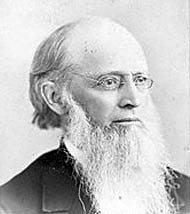Readings:
Isaiah 49:22-23
Psalm 96:1-7
Acts 1:1-9
Luke 10:1-12Preface of Pentecost
[Common of a Missionary]
[Common of a Pastor]
[For the Ministry II]
[For the Mission of the Church]
PRAYER (traditional language):
O God, who in thy providence didst call Channing Moore Williams to the ministry of this church and gave him the gifts and the perseverance to preach the Gospel in new lands: Inspire us, by his example and prayers, to commit our talents to thy service, confident that thou dost uphold those whom thou dost call; through Jesus Christ our Lord, who liveth and reigneth with thee and the Holy Ghost, one
God, for ever and ever. Amen.
PRAYER (contemporary language)
O God, who in your providence called Channing Moore Williams to the ministry of this church and gave him the gifts and the perseverance to preach the Gospel in new lands: Inspire us, by his example and prayers, to commit our talents to your service, confident that you uphold those whom you call; through Jesus Christ our Lord, who lives and reigns with you and the Holy Spirit, one God, for ever and ever. Amen.
Lessons revised at General Convention 2024.
Return to Lectionary Home Page
Webmaster: Charles Wohlers
Last updated: 5 Oct. 2024
CHANNING MOORE WILLIAMS
MISSIONARY TO ASIA (2 DEC. 1910)
 Williams was born in Richmond, Virginia, in 1829, and ordained deacon
in 1855. The Episcopal Church sent him to China, where he was ordained
priest in 1857. In 1859 he was sent to Nagasaki, Japan, and in 1866 was
consecrated Bishop of China and Japan. In 1868 Japan was opened to far
greater contact with the West than before, and he determined that he could
achieve best results by concentrating his efforts on Japan. In 1874 (or
is that 1877?) a new bishop (Samuel Isaac Joseph Schereschewski, see October
14) was consecrated for China, and Williams went to Tokyo (then called
Edo or Yedo), where he founded what is now St Paul's University. In 1878
he helped unite several mission efforts in the formation of the Nippon
Sei Ko Kai, the Holy Catholic Church in Japan. In 1889 his health
began to fail, and he asked to be relieved. In 1893 a successor was appointed,
and Williams stayed on, living in Kyoto and helping to open new mission
stations. He returned to America in 1908 and died 2 December 1910.
Williams was born in Richmond, Virginia, in 1829, and ordained deacon
in 1855. The Episcopal Church sent him to China, where he was ordained
priest in 1857. In 1859 he was sent to Nagasaki, Japan, and in 1866 was
consecrated Bishop of China and Japan. In 1868 Japan was opened to far
greater contact with the West than before, and he determined that he could
achieve best results by concentrating his efforts on Japan. In 1874 (or
is that 1877?) a new bishop (Samuel Isaac Joseph Schereschewski, see October
14) was consecrated for China, and Williams went to Tokyo (then called
Edo or Yedo), where he founded what is now St Paul's University. In 1878
he helped unite several mission efforts in the formation of the Nippon
Sei Ko Kai, the Holy Catholic Church in Japan. In 1889 his health
began to fail, and he asked to be relieved. In 1893 a successor was appointed,
and Williams stayed on, living in Kyoto and helping to open new mission
stations. He returned to America in 1908 and died 2 December 1910.